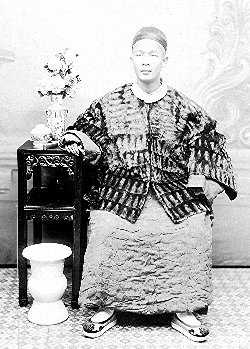|
[Index] Chinese
Voting in Tuscarora
Selecting tong leaders in Tuscarora's Chinatown was totally different from today's elections. Perhaps they had the right idea back then. The election lasted one day - that's a God send. We have to endure months of campaigning filled with innuendoes, outright lying, promises that will not be fulfilled and, likely, the election results will end up in court. What have we done to ourselves in the 21st century? How did the Tuscarora Chinese pull it off without all this tomfoolery? There were two tongs and two Chinatowns, more or less. Each joss house settled conflicts in business, affairs of the heart, and both owned local laundries. Sometimes they grub staked Chinese men who worked their own placer claims. The tongs were what held the Chinese residents together socially and in business matters. An elected president ruled both tongs. Quong Hi and Lee Ah Lake wanted the job. It wouldn't have mattered if they had campaigned their brains out - that wasn't the way it was done. Chinese New Years was the day of elections. Most of the silver camp's population of whites, Chinese, and Indians gathered to watch. It was in late February. The snow was a foot or more deep. Forty or fifty men from the tongs circled around a wood block. The election was about to begin. A rocket flared and an unguided bomb was launched. It climbed high into the gray winter sky until it could no higher. Slowly the nose turned down and it fell to earth. There would be 20 of them to determine the election results. The bombs were filled with presents, candy, and cookies. In one was a gold ring - the tong that found the ring would win the election. Big China George caught the first bomb and took off running for his joss house. All the men jumped on him biting, kicking, grunting, scratching, and screaming. Just about any method of dealing out hurt was used, with one exception. No pigtail pulling. George finally struggled free of the pileup, threw the bomb to a team member who raced toward his joss house, all the while fending off fighters from the other house. Finally, he laid the bomb on the steps of his joss house. That was the signal for all the fighters to run full speed back to the schoolyard to skirmish for the next bomb. This continued until all 20 rockets were fired and fought over. Their personal reward was that each man who brought a bomb to a joss house would be a voting member of the general council of the two tongs for the next year. The smoke cleared and bombs were counted. The piles of bombs were almost equal although that mattered little. Which house found the gold ring? Would the new leader be Quong Hi or Lee Ah Lake? It was time to wait while the search for the gold ring took place. On the street outside it was one big party that included most everyone in town. Tuscarora resident Syd Tremewan recalled: "It was a wonderful time for kids! There was candied ginger and coconut, strange nuts, funny small prizes, little fruit cakes, firecrackers - all kinds of firecrackers everywhere." Finally, two strong men emerged carrying a ceremonial chair atop two poles. The new leader was carried proudly and ceremoniously to head the victory parade through town. He proudly wore a beautiful jeweled and brocade cap. His robe was midnight silk with embroideries of red, blue, and green. Gold and silver dragons, exotic birds, and delicate flowers enhanced the designs even more. Riding in the chair was Lee Ah Lake!
The election was over. Tuscarora settled back into its daily life to remember the festivities and look forward to next year's elections. Many of the Chinese men nursed bruises and sporting black eyes for awhile. Honest signs of battle for an important battle - the election! Perhaps this is not the way to elect a new leader but, by golly, it was a great spectator event. And, it lasted but one day. Those were the good old days. Source: Aged in Sage, 1964, by Jean McElrath. A word about Ms. McElrath. She authored two books of northeastern Nevada history while living in Wells. She wrote both while paralyzed and blind. She is no longer alive but the historical vignettes she wrote are important segments of local history that would have been lost forever if she had not taken on the job. Thanks, Jean. Photograph of Lee Ah Lake from the Northeastern Nevada Museum, Elko, files. ©Copyright 2004 by Howard Hickson. |
